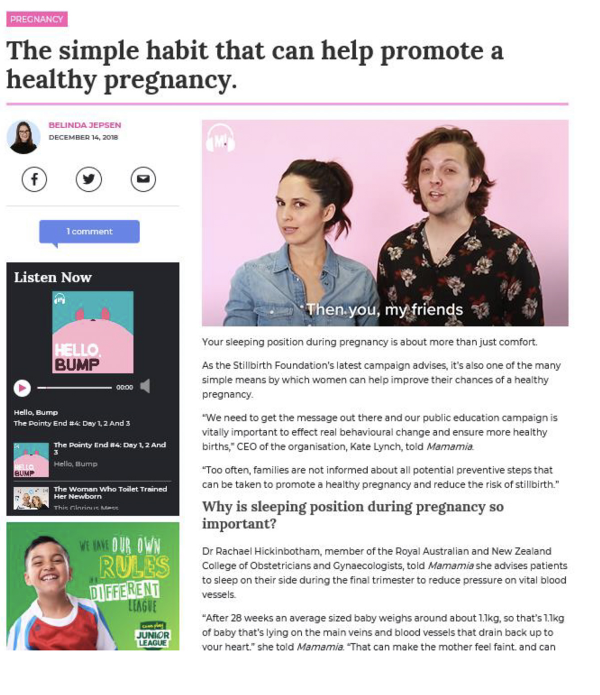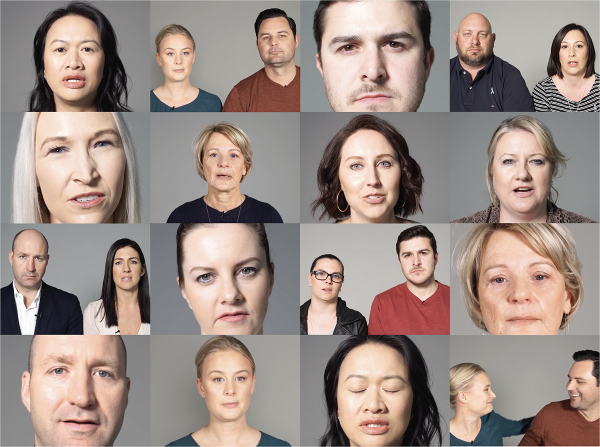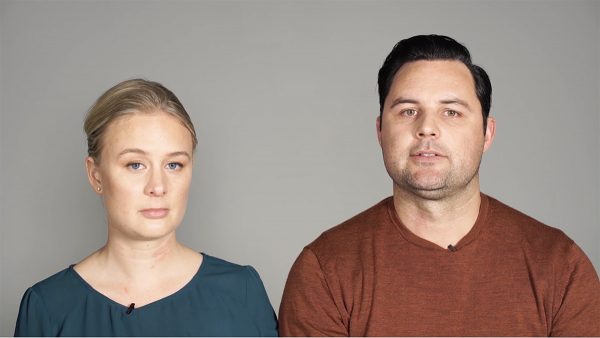










Project Overview
Six babies are stillborn in Australia every single day. That's over 2,200 a year, making stillbirth the number one cause of death for children under 12 months of age. Australian research has confirmed that up to 10% of Australian stillbirths could be prevented if pregnant mothers slept on their side during the third trimester of pregnancy. In terms of reducing preventable stillbirths, Australia ranks 28 out of 36 OECD countries. Our campaign was the first step in lowering this health crisis.
The funds to mount this campaign were raised by family and friends in honour of Bluey Joshua Ryan, born still 16 January 2018.
Project Commissioner
Project Creator
Project Brief
The Stillbirth Foundation had to generate a change in behaviour in expectant mothers and encourage them to sleep on their side. Despite the large and engaged stillbirth community, our challenge was to ensure this information was not misinterpreted as blaming stillbirths on mothers. We also knew that pregnant mothers tended to disengage with messaging about stillbirth.
In carrying out the project, we had to be sensitive on three main points:
1. Even if a mother sleeps on her side for her whole pregnancy, she may still have a stillborn child – although sleeping on her back doubles the risk.
2. It is impossible for anyone to sleep on their side all night. Once you fall asleep, you can't control your movements. That meant we had to be careful not to cause anxiety for mothers. Instead of the message focussing on not rolling over in their sleep, we had to emphasise that they simply needed to resettle on their side.
3. The causes of stillbirth are largely unknown, with 60% of autopsies being inconclusive. Side sleeping is a risk-reduction strategy only, and won't solve the problem completely.
Project Innovation/Need
There were two audiences that needed to be engaged with this campaign – parents of stillborn babies, and expectant mothers.
We developed a plan to create two separate communication pieces. The first was for families who had experienced stillbirth, in order to prepare them for information which would soon be in the public sphere. The challenge was to introduce this information to them in a way that did not leave them feeling blamed or isolated. We decided the best way to do this was to give them ownership of the message – it was parents of stillborn babies who had funded the research, so the findings were the legacy of their children.
Our second communication challenge was about speaking to pregnant mothers about a way to prevent cause stillbirth – without talking about stillbirth. Our research determined that could speak about 'healthy, happy babies', and that much like the well-known warning to avoid soft cheese during pregnancy, mothers would follow this recommendation without immediately needing to understand why. We made it possible for inquisitive mothers to learn about the medical reasoning behind this if they wanted (that there is a major vein which can be compressed if a mother lays on her back, altering placental blood flow). At the bottom of the landing page, we revealed that sleeping on one's back could lead to stillbirth. Only the most determined person would get that far.
Design Challenge
Challenge 1: Reaching parents of stillborn babies to communicate that this research is the legacy of their child, and finding a way to acknowledge that their loss can't be reversed by these findings. We felt this would best be done in the form of a video rather than in writing and we needed to ensure it was effective, clear, reassuring and genuine. We created a script and shoot style video, delivered from still-parents to still-parents in a simple yet sensitive way. The video acknowledged that the information was too late for them, but that their fundraising efforts could help save other babies. This was then shared through closed communities and sector organisations.
Challenge 2: Reaching pregnant mothers and encouraging them to sleep on their side. The key was to keep the message simple, making it shareable and memorable while being careful not to cause alarm. We used Facebook to disseminate the message and partnered with Mamamia to distance this information from the Stillbirth Foundation. This raised levels of engagement with pregnant mothers.
Effectiveness
The first video was distributed and shared widely throughout the stillbirth community, generating over 5,000 views and 200 comments on closed Facebook groups. The sentiment was received exactly as we wanted it to, with the majority of responses being positive. The video was also referenced at an industry symposium, increasing the amount of shares.
With a limited budget, the Facebook campaign ran for a couple of weeks and received an excellent response. Our target was impressions, as we aimed for the message to appear frequently enough that the target audience of pregnant mothers and their support networks heard our message.
When Mamamia shared a post about the campaign via Facebook, it achieved a reach of over 450k, 58k engagements, 805 likes, 348 comments, and 153 shares. The video accumulated 667k views, 195 comments, and was shared 125 times,
These videos were also sent to the NSW Department of Health to show our efforts. This led to the securing of the Stillbirth Foundation's first government grant of $105,000. These funds are being used to develop further communication pieces for medical practitioners to communicate this message to mothers in their care.
Marketing - Film or Video
This award celebrates creative and innovative visual and audio corporate communications that place an emphasis on design values. Consideration given to the technical, conceptual and aesthetic elements, viewer engagement and message delivery.
More Details

